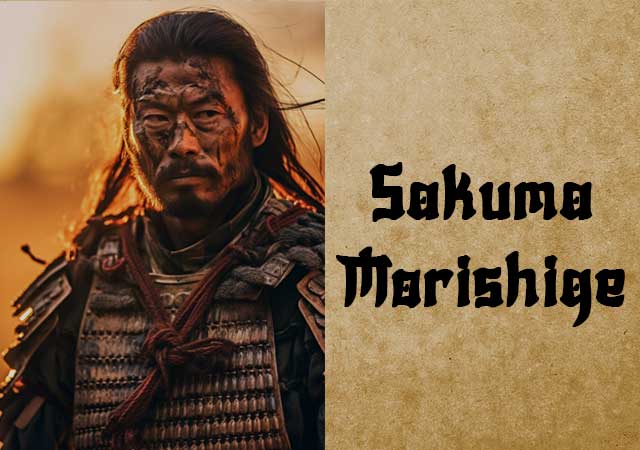
Sakuma Morishige, also known as Daigaku, served as a samurai and held mastery over Gokiso Nishi Castle, which is now known as Biyo Shrine in Nagoya City, during the Sengoku (Warring States) period. Initially, he served under Oda Nobunaga’s younger brother, Nobuyuki, and later directly under Nobunaga himself. His presence is documented in the Shincho-Koki, the Chronicles of Lord Nobunaga, where he is noted to have attended the funeral of Oda Nobuhide, Nobunaga’s father, in 1552.
Before the Battle of Ino in 1556, where Nobunaga clashed with his brother, Nobunaga erected Fort Nazuka in Nishi-ku, Nazuka, Nagoya City, placing Sakuma Morishige in charge. During this conflict, Sakuma notably claimed the head of Hashimoto Juzo, a general under Oda Nobuyuki, earning him significant rewards.
Prior to the pivotal Battle of Okehazama in 1560, Morishige was appointed as the castellan of Marune Castle, located in Nagoya City’s Midori Ward. This castle served as a crucial border post in the defense against the forces of the Imagawa clan. It was Sakuma who first alerted Nobunaga to the fortress being under attack.
Marune Castle found itself besieged by the forces commanded by Matsudaira Motoyasu, who would later gain renown as Tokugawa Ieyasu. At the time, Ieyasu was still a hostage of the Imagawa clan until his liberation following the demise of Imagawa Yoshimoto. Employing the newly introduced matchlock guns, which had swiftly gained favor among the samurai class, Ieyasu launched repeated attacks on the small castle. Tragically, on June 11, 1560, Morishige was struck by a bullet and killed instantly. The castle subsequently fell to Ieyasu and the advancing Imagawa forces. Shortly after this event, Oda Nobunaga and his troops would defeat Imagawa Yoshimoto, granting Ieyasu the freedom to return to his hometown of Okazaki.
See also
-
Yamagata Masakage

Masakage was one of Takeda Shingen’s most loyal and capable commanders. He was included in the famous list of the “Twenty-Four Generals of Takeda Shingen” and also belonged to the inner circle of four especially trusted warlords known as the Shitennō.
-
Yagyu Munenori

Yagyū Munenori began his service under Tokugawa Ieyasu while his father, Yagyū Muneyoshi, was still at his side. In 1600, Munenori took part in the decisive Battle of Sekigahara. As early as 1601, he was appointed a kenjutsu instructor to Tokugawa Hidetada, Ieyasu’s son, who later became the second shogun of the Tokugawa clan.
-
Yagyu Muneyoshi

A samurai from Yamato Province, he was born into a family that had been defeated in its struggle against the Tsutsui clan. Muneyoshi first took part in battle at the age of sixteen. Due to circumstances beyond his control, he was forced to enter the service of the Tsutsui house and later served Miyoshi Tōkei. He subsequently came under the command of Matsunaga Hisahide and in time became a vassal first of Oda and later of Toyotomi.
-
Endo Naozune

Naozune served under Azai Nagamasa and was one of the clan’s leading vassals, renowned for his bravery and determination. He accompanied Nagamasa during his first meeting with Oda Nobunaga and at that time asked for permission to kill Nobunaga, fearing him as an extremely dangerous man; however, Nagamasa did not grant this request.
-
Hosokawa Sumimoto

Sumimoto came from the Hosokawa clan: he was the biological son of Hosokawa Yoshiharu and at the same time the adopted son of Hosokawa Masamoto, the heir of Hosokawa Katsumoto, one of the principal instigators of the Ōnin War. Masamoto was homosexual, never married, and had no children of his own. At first he adopted Sumiyuki, a scion of the aristocratic Kujō family, but this choice provoked dissatisfaction and sharp criticism from the senior vassals of the Hosokawa house. As a result, Masamoto changed his decision and proclaimed Sumimoto as his heir, a representative of a collateral branch of the Hosokawa clan that had long been based in Awa Province on the island of Shikoku. Almost immediately after this, the boy became entangled in a complex and bitter web of political intrigue.
-
Honda Masanobu

Masanobu initially belonged to the retinue of Tokugawa Ieyasu, but later entered the service of Sakai Shōgen, a daimyo and priest from Ueno. This shift automatically made him an enemy of Ieyasu, who was engaged in conflict with the Ikkō-ikki movement in Mikawa Province. After the Ikkō-ikki were defeated in 1564, Masanobu was forced to flee, but in time he returned and once again entered Ieyasu’s service. He did not gain fame as a military commander due to a wound sustained in his youth; nevertheless, over the following fifty years he consistently remained loyal to Ieyasu.
-
Honda Masazumi

Masazumi was the eldest son of Honda Masanobu. From a young age, he served Tokugawa Ieyasu alongside his father, taking part in the affairs of the Tokugawa house and gradually gaining experience in both military and administrative matters. At the decisive Battle of Sekigahara in 1600, Masazumi was part of the core Tokugawa forces, a clear sign of the high level of trust Ieyasu placed in him. After the campaign ended, he was given a highly sensitive assignment—serving in the guard of the defeated Ishida Mitsunari, one of Tokugawa’s principal enemies—an obligation that required exceptional reliability and caution.
-
Hojo Shigetoki

Hōjō Shigetoki, the third son of Hōjō Yoshitoki, was still very young—only five years old—when his grandfather Tokimasa became the first member of the Hōjō clan to assume the position of shogunal regent.

